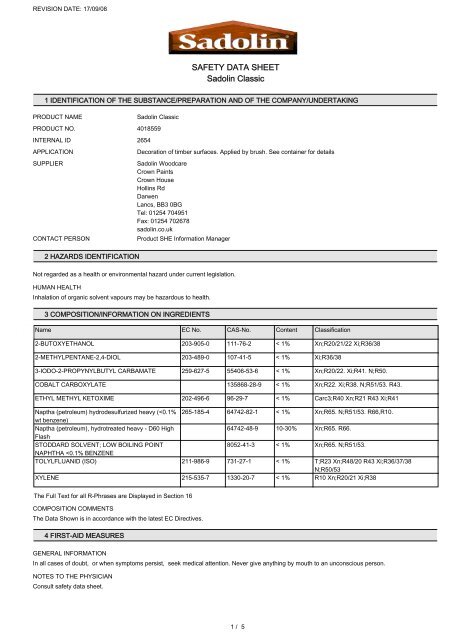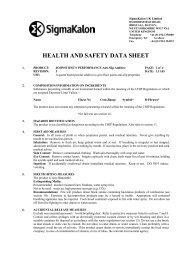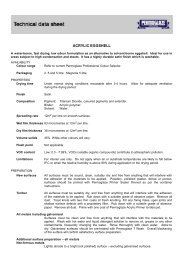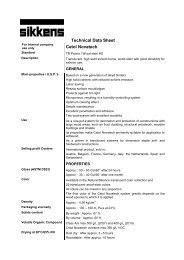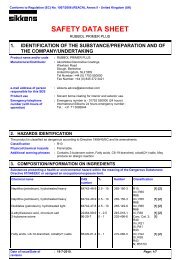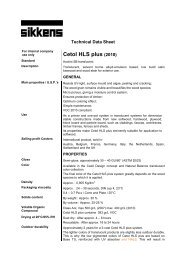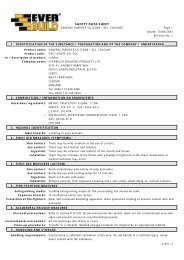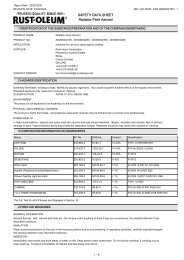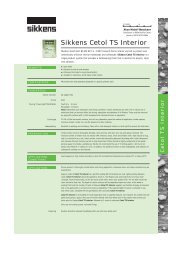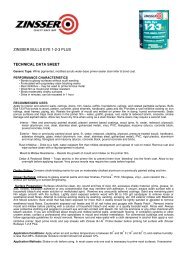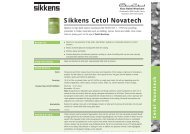SAFETY DATA SHEET Sadolin Classic - Decorating Warehouse
SAFETY DATA SHEET Sadolin Classic - Decorating Warehouse
SAFETY DATA SHEET Sadolin Classic - Decorating Warehouse
Create successful ePaper yourself
Turn your PDF publications into a flip-book with our unique Google optimized e-Paper software.
REVISION DATE: 17/09/08<br />
<strong>SAFETY</strong> <strong>DATA</strong> <strong>SHEET</strong><br />
<strong>Sadolin</strong> <strong>Classic</strong><br />
1 IDENTIFICATION OF THE SUBSTANCE/PREPARATION AND OF THE COMPANY/UNDERTAKING<br />
PRODUCT NAME <strong>Sadolin</strong> <strong>Classic</strong><br />
PRODUCT NO. 4018559<br />
INTERNAL ID 2654<br />
APPLICATION Decoration of timber surfaces. Applied by brush. See container for details<br />
SUPPLIER<br />
<strong>Sadolin</strong> Woodcare<br />
Crown Paints<br />
Crown House<br />
Hollins Rd<br />
Darwen<br />
Lancs, BB3 0BG<br />
Tel: 01254 704951<br />
Fax: 01254 702678<br />
sadolin.co.uk<br />
CONTACT PERSON Product SHE Information Manager<br />
2 HAZARDS IDENTIFICATION<br />
Not regarded as a health or environmental hazard under current legislation.<br />
HUMAN HEALTH<br />
Inhalation of organic solvent vapours may be hazardous to health.<br />
3 COMPOSITION/INFORMATION ON INGREDIENTS<br />
Name EC No. CAS-No. Content Classification<br />
2-BUTOXYETHANOL 203-905-0 111-76-2 < 1% Xn;R20/21/22 Xi;R36/38<br />
2-METHYLPENTANE-2,4-DIOL 203-489-0 107-41-5 < 1% Xi;R36/38<br />
3-IODO-2-PROPYNYLBUTYL CARBAMATE 259-627-5 55406-53-6 < 1% Xn;R20/22. Xi;R41. N;R50.<br />
COBALT CARBOXYLATE 135868-28-9 < 1% Xn;R22. Xi;R38. N;R51/53. R43.<br />
ETHYL METHYL KETOXIME 202-496-6 96-29-7 < 1% Carc3;R40 Xn;R21 R43 Xi;R41<br />
Naptha (petroleum) hydrodesulfurized heavy (
REVISION DATE: 17/09/08<br />
INHALATION<br />
<strong>Sadolin</strong> <strong>Classic</strong><br />
Remove to fresh air, keep the patient warm and at rest. If breathing has stopped, administer artificial respiration. Give nothing by mouth. If<br />
unconscious, place in a prone position with head to the side (recovery position) and seek medical advice.<br />
INGESTION<br />
If accidentally swallowed obtain immediate medical advice. Show this safety data sheet. Keep at rest. Do not induce vomiting. If conscious<br />
give milk or water to drink.<br />
SKIN CONTACT<br />
Remove contaminated clothing. Wash skin thoroughly with soap and water or use a proprietary skin cleaner. Do not use solvents or<br />
thinners.<br />
EYE CONTACT<br />
Contact lenses should be removed. Irrigate copiously with clean, fresh water for at least 10 minutes, holding the eyelids apart, and seek<br />
medical advice.<br />
5 FIRE-FIGHTING MEASURES<br />
EXTINGUISHING MEDIA<br />
Extinguish with alcohol-resistant foam, carbon dioxide, dry powder or water fog. Do not use water jet.<br />
SPECIAL FIRE FIGHTING PROCEDURES<br />
Cool closed containers exposed to fire with water spray. Do not allow run-off from fire fighting to enter drains or water courses.<br />
UNUSUAL FIRE & EXPLOSION HAZARDS<br />
No unusual fire or explosion hazards noted.<br />
SPECIFIC HAZARDS<br />
Fire will produce dense black smoke containing hazardous products of combustion (see section10). Decomposition products may be<br />
hazardous to health.<br />
PROTECTIVE MEASURES IN FIRE<br />
Appropriate self-contained breathing apparatus may be required.<br />
6 ACCIDENTAL RELEASE MEASURES<br />
PERSONAL PRECAUTIONS<br />
Exclude sources of ignition and ventilate the area. Floors may become slippery. Warn others of the dangers present and exclude<br />
non-essential personnel. Refer to protective measures listed in sections 7 and 8. Avoid breathing vapours.<br />
ENVIRONMENTAL PRECAUTIONS<br />
Do not allow to enter drains or water courses. If the product enters drains or sewers the local water company should be contacted<br />
immediately; in the case of contamination or streams, rivers or lakes, the Environment Agency.<br />
SPILL CLEAN UP METHODS<br />
Contain and collect spillages with non-combustible absorbent materials, e.g. sand, earth, vermiculite, diatomaceous earth and place in a<br />
clearly labelled suitable container for disposal in accordance with the waste regulations (see section 13). Clean preferably with a detergent;<br />
avoid the use of solvents.<br />
7 HANDLING AND STORAGE<br />
USAGE PRECAUTIONS<br />
Solvent vapours are heavier than air and may spread along floors. They may form explosive mixtures with air. For personal protection, see<br />
section 8. Avoid skin and eye contact. Avoid inhalation of vapour. Prevent the creation of flammable or explosive concentrations of vapour<br />
in air and avoid vapour concentrations higher than the occupational exposure limits. Additionally, the product should only be used in areas<br />
from which all naked lights and other sources of ignition have been excluded. Electrical equipment should be protected to the appropriate<br />
standard. Keep the container tightly closed. Exclude sources of heat, sparks and open flame. Smoking, eating and drinking should be<br />
prohibited in areas of storage and use. Never use pressure to empty; the container is not a pressure vessel. Always keep in the same<br />
material as the supply container. Good housekeeping standards and regular safe removal of waste materials will minimise risks of<br />
spontaneous combustion and other fire hazards. The Manual Handling Operations Regulations may apply to the handling of containers of<br />
this product. Packs with a volume content of 5 litres or more may be marked with a maximum gross weight. To assist employers the<br />
following method of calculating the weight for any pack size is given. Take the pack size volume in litres and multiply this figure by the<br />
specific gravity value given in section 9. This will give the net weight of the coating in kilograms. Allowance will then have to be made for<br />
the immediate packaging to give an approximate gross weight.<br />
USAGE DESCRIPTION<br />
Use product only in accordance with methods listed in section 1.<br />
STORAGE PRECAUTIONS<br />
Observe label precautions. Store between 5°C and 30°C in a dry, well ventilated place. Prevent unauthorised access. Store separately<br />
from oxidising agents and strongly acidic materials.<br />
STORAGE CLASS<br />
The storage of this product is not subject to any statutory requirements.<br />
8 EXPOSURE CONTROLS/PERSONAL PROTECTION<br />
2 /<br />
5
REVISION DATE: 17/09/08<br />
Name<br />
2-BUTOXYETHANOL<br />
2-METHYLPENTANE-2,4-DIOL<br />
Naptha (petroleum) hydrodesulfurized heavy (
REVISION DATE: 17/09/08<br />
<strong>Sadolin</strong> <strong>Classic</strong><br />
VISCOSITY 90-100 s 23 FLASH POINT (°C) >61 CC (Closed cup).<br />
10 STABILITY AND REACTIVITY<br />
STABILITY<br />
Stable under the recommended storage and handling conditions (see section 7).<br />
MATERIALS TO AVOID<br />
Keep away from oxidising agents and strongly alkaline and strongly acidic materials to prevent the possiblility of exothermic reaction.<br />
HAZARDOUS DECOMPOSITION PRODUCTS<br />
In a fire, hazardous decomposition products such as smoke, carbon monoxide, carbon dioxide and oxides of nitrogen may be produced.<br />
11 TOXICOLOGICAL INFORMATION<br />
GENERAL INFORMATION<br />
Exposure to organic solvent vapours in excess of the stated workplace exposure limit may result in adverse effects on the liver renal and<br />
central nervous systems.<br />
INHALATION<br />
Exposure through inhalation may result in the following effects: headache, dizziness, fatigue, muscular weakness, drowsiness and in<br />
extreme cases, loss of consciousness.<br />
INGESTION<br />
Ingestion may result in the following effects: sore throat, abdominal pain, drowsiness, nausea, vomiting and diarrhoea. Other effects may<br />
be described as for exposure to vapours.<br />
SKIN CONTACT<br />
Solvents may cause the above effects by exposure through the skin. Repeated or prolonged contact with the product may lead to removal<br />
of natural fats from the skin resulting in non-allergic contact dermatitis and absorption through the skin.<br />
EYE CONTACT<br />
Splashes in the eyes may cause irritation and reversible local damage.<br />
12 ECOLOGICAL INFORMATION<br />
ECOTOXICITY<br />
The product has been assessed following the conventional method in CHIP and is classified for ecological hazards accordingly. See<br />
section 2 and 15 for details.<br />
13 DISPOSAL CONSIDERATIONS<br />
GENERAL INFORMATION<br />
Waste including emptied containers, are classed as special waste and should be disposed of in accordance with regulations made under<br />
the Environmental Protection Act, Special Waste regulations. Using the information provided in this safety data sheet, advice should be<br />
obtained from the environment agency as to how the special waste regulations apply. For further information, see "Waste Management -<br />
The Duty of Care - A Code of Practice" available from HMSO.<br />
DISPOSAL METHODS<br />
Do not allow into drains or water courses or dispose of where ground or surface waters may be affected.<br />
14 TRANSPORT INFORMATION<br />
GENERAL The product is not covered by international regulation on the transport of dangerous goods (IMDG, IATA,<br />
ADR/RID).<br />
MARINE POLLUTANT<br />
No transport warning sign required.<br />
No.<br />
15 REGULATORY INFORMATION<br />
RISK PHRASES<br />
<strong>SAFETY</strong> PHRASES<br />
UK REGULATORY REFERENCES<br />
NC Not classified.<br />
P14 Contains COBALT CARBOXYLATE,ETHYL METHYL KETOXIME,TOLYLFLUANID<br />
(ISO). May produce an allergic reaction.<br />
The products are classified and supplied in accordance with the Chemicals (Hazard Information Packaging for supply) regulations (CHIP).<br />
The information contained in this safety data sheet does not constitute the user's own assessment of workplace risks as required by other<br />
health and safety legislation. The provision of the Health and Safety at Work Act and the Control of Substances Hazardous to Health<br />
regulations apply to the use of this product at work.<br />
4 /<br />
5
REVISION DATE: 17/09/08<br />
EU DIRECTIVES<br />
<strong>Sadolin</strong> <strong>Classic</strong><br />
Dangerous Substance Directive 67/548/EEC. Dangerous Preparations Directive 1999/45/EC.<br />
APPROVED CODE OF PRACTICE<br />
Approved classification and labelling guide (Fifth edition) The compilation of safety data sheets (Third edition)<br />
GUIDANCE NOTES<br />
Workplace Exposure Limits EH40. Storage of Flammable Liquids in Containers, HS(G)51 Storage of Packaged Dangerous Substances,<br />
HS(G)71<br />
NATIONAL REGULATIONS<br />
The Control Of Substances Hazardous to Health regulations (as amended) The Manual Handling Operations regulations (as amended) The<br />
Environmental Protection (Duty of Care) regulations (as amended) The Chemicals (Hazard Information and Packaging) for supply<br />
regulations (as amended) The Health and Safety at Work act 1974 (as amended)<br />
16 OTHER INFORMATION<br />
GENERAL INFORMATION<br />
The information contained in this safety data sheet is provided in accordance with the requirements of the CHIP regulations. The product<br />
should not be used for purposes other than those shown in section 1 without first referring to the supplier and obtaining written handling<br />
instruction. As the specific conditions of use of the product are outside the suppliers control, the user is responsible for ensuring that the<br />
requirements of relevant legislation are complied with.<br />
REVISION COMMENTS<br />
This information is provided in a revised format to that previously produced.<br />
ISSUED BY<br />
Product SHE Information Manager<br />
REVISION DATE 17/09/08<br />
SDS NO. Revision 2<br />
RISK PHRASES IN FULL<br />
R10<br />
R20/21<br />
R20/21/22<br />
R20/22<br />
R21<br />
R22<br />
R23<br />
R36/37/38<br />
R36/38<br />
R38<br />
R40<br />
R41<br />
R43<br />
R48/20<br />
R50<br />
R50/53<br />
R51/53<br />
R65<br />
R66<br />
Flammable.<br />
Harmful by inhalation and in contact with skin.<br />
Harmful by inhalation, in contact with skin and if swallowed.<br />
Harmful by inhalation and if swallowed.<br />
Harmful in contact with skin.<br />
Harmful if swallowed.<br />
Toxic by inhalation.<br />
Irritating to eyes, respiratory system and skin.<br />
Irritating to eyes and skin.<br />
Irritating to skin.<br />
Limited evidence of a carcinogenic effect.<br />
Risk of serious damage to eyes.<br />
May cause sensitisation by skin contact.<br />
Harmful: danger of serious damage to health by prolonged exposure through inhalation.<br />
Very toxic to aquatic organisms.<br />
Very toxic to aquatic organisms, may cause long-term adverse effects in the aquatic environment.<br />
Toxic to aquatic organisms, may cause long-term adverse effects in the aquatic environment.<br />
Harmful: may cause lung damage if swallowed.<br />
Repeated exposure may cause skin dryness or cracking.<br />
DISCLAIMER<br />
The information provided in this safety data sheet is based on the present state of knowledge and current national legislation. It provides guidance on<br />
health and safety and environmental aspects and should not be construed as any guarantee of technical performance or suitablility for particular<br />
applications.<br />
5 /<br />
5


